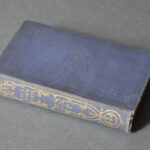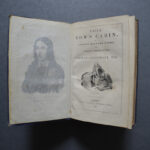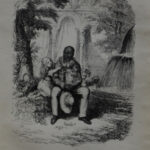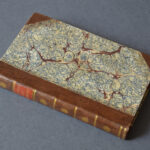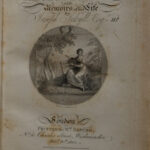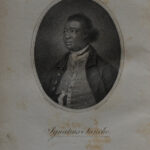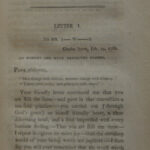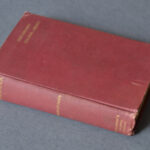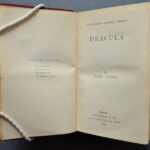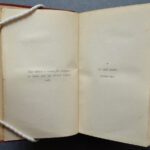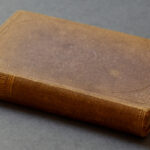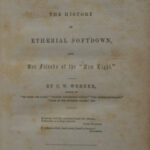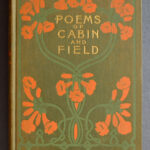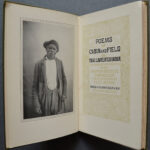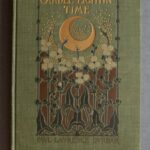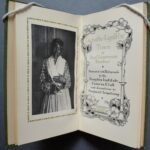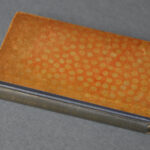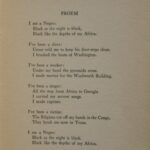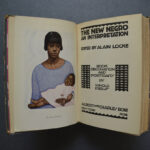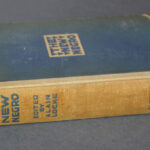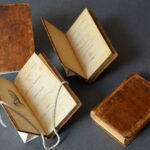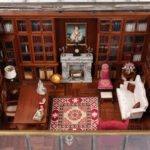Hi All! Judy Guston, Rosenbach Curator and Director of Collections here. Hoping you and yours are safe and healthy. The Collections team and I have been at the museum doing various tasks for the past few weeks and it’s certainly not the same without you there.
Here’s an overview on how our collections have come together over the years and how we continue to add to them. Some of the newly acquired objects should give you even more reasons to join our online programs and then—when it’s possible again—come back to see us in person!
Although staff have been off-site much of the time during this ongoing health crisis, we’ve been busy with many aspects of our usual work. For those of us in the Collections department, part of that work involves “acquisitions,” or bringing new objects into our collections.
We’re often asked if everything in the collection belonged to A.S.W. Rosenbach and Philip Rosenbach, our founders, but it’s actually the case that somewhere around one third of the approximately 400,000 objects in The Rosenbach’s collections were acquired after our founders’ era (i.e., post-1953). These objects came into the collection by institutional purchase, as gifts by bequest or donation, and as purchases made possible by funds from individuals and/or foundations. The Rosenbach has a small, dedicated, acquisition fund that is carefully stewarded according to policy and from which funds are expended only with collaboration among staff and oversight by leadership and board. We are strategic in our collecting.
We use our objects to communicate through public programming on site and, especially now, online. They appear in exhibitions and inspire courses. We put them in your hands during our signature hands-on programming and through research in our library. It’s important that our collections remain fresh so the stories we tell address contemporary issues even as the objects themselves may date to the past. We build on our strengths, but also give voice to new interpretations, people who may have been overlooked, and works that may have been underappreciated. Building on our collection’s areas of diversity and enhancing our programming and research through these new acquisitions is part of The Rosenbach’s Commitment to Equity.
Of course, you can only acquire what’s on the market at a given time and we need to respond when something of importance to the institution becomes available. What follows is a group of objects The Rosenbach acquired between early March and late July 2020. This group speaks to a range of collecting goals and interests. Many of these objects will appear in upcoming programs. I hope you enjoy learning about them!
Purchases from the New York Antiquarian Book Fair, March 2020
In early March, just as news of the novel coronavirus began to emerge, a small band of intrepid Rosenbach bibliophiles made one last outing to New York’s premier book fair. After making three exciting purchases, we retreated to Philadelphia, and, as it turned out, to our homes, just a week later.
We went to the fair, as in previous years, hoping to find a first American edition of Uncle Tom’s Cabin in good condition, as we didn’t already have a copy of this socially and politically significant novel—that was the best-selling novel of the nineteenth century. This trip proved the charm, but instead of the first American edition, we found the second British edition—the first with illustrations by George Cruikshank, whose work we have in abundance at The Rosenbach. Such connections are useful for interpretation—as illustrations are helpful for visual interpretation of literary works. The presence of this work in England also helps us discuss abolition as an international movement and connects this book to our second acquisition from the fair.
Learn more about this object in this fall’s Behind the Bookcase Tour: Anti-Slavery and Abolition in the Early North Atlantic World.
Harriet Beecher Stowe (1811-1896), Uncle Tom’s cabin; with 27 illustrations on wood by George Cruikshank. London: John Cassell, 1852. AL1 .S892u 852c
Talking with booksellers about collecting goals can create opportunities to find interpretive gems. We are trying to better represent the past as it was in its true diversity, which may mean purchasing works that are lesser known and elevating voices that many of us haven’t yet heard. That was our conversation when we found Letters of the Late Ignatius Sancho, an African. This is the fifth edition of Sancho’s letters, but the first published by his son, William Sancho, making this volume the first book both written and published by people of African descent. Born into slavery, the elder Sancho became a London shopkeeper and a respected member of the local literati, interacting with writers now found on The Rosenbach’s shelves. He was the first Black critic to comment on Phillis Wheatley’s poetry. His reflections on his own life and circumstances, slavery, and the abolitionist cause give lasting voice to his and his family’s lives during this period.
Learn more about this object in this fall’s Behind the Bookcase Tour: Anti-Slavery and Abolition in the Early North Atlantic World.
Ignatius Sancho (1729-1780), Letters of the late Ignatius Sancho, an African; to which are prefixed, memoirs of his life. London: Printed for W. Sancho, 1803. EL2 .S211l 803
Sometimes there are other kinds of surprises. The Rosenbach has owned two first editions of Dracula—both post-founder acquisitions—for decades. Both have their famous yellow covers with red titles. But blood-red covers? And there it was: the colonial edition, made for circulation in India and the British colonies only. After a recent book fair acquisition of the first illustrated and abridged edition of Dracula (by Stoker himself!), this was a rarity we had to have for our growing Dracula and vampire collection!
Learn more about this object: Sundays with Dracula on August 30, 2020. See rosenbach.org for details.
Bram Stoker (1847-1912), Dracula. London: Hutchinson, 1897. (Hutchinson’s colonial library) EL3. S874d 897b
Further expanding our Vampire Holdings
Later in the spring, a listing from another trusted bookseller alerted us to Spiritual Vampirism, which broadens our vampire holdings and further describes the context of Stoker’s important work. It introduces a psycho-spiritual vampire character and a female one at that.
Learn more about this object: Sundays with Dracula on August 30, 2020. See rosenbach.org for details.
Charles Wilkins Webber (1819-1856), Yieger’s cabinet. Spriritual vampirism: The history of Etherial Softdown, and her friends of the “New Light.” Philadelphia: Lippincott, Grambo & Co., 1853.
AL1 .W371y
Strengthening Holdings, Programs, Exhibitions, and Diversity
The Rosenbach already had a copy of Black poet Paul Laurence Dunbar’s Oak and Ivy in its collections. Research on Dunbar led to plans for a major exhibition and program suite based on his enormously influential wife, activist/educator/writer Alice Dunbar-Nelson. When two of his other works, Poems of Cabin and Field and Candle-Lightin‘ Time, became available, we acquired both to expand our holdings and to enhance our interpretive abilities during the upcoming project and beyond.
Learn more about these objects in this fall’s online exhibition and program suite: I Am and American! The Authorship and Activism of Alice Dunbar-Nelson.
Paul Laurence Dunbar (1872-1906), Poems of cabin and field. New York: Dodd, Mead and Company, 1900. AL1 .D899p 900
Paul Laurence Dunbar (1872-1906), Candle-lightin‘ time. New York: Dodd Mead & Co., 1901. AL1 .D899c 901
Expanding Existing Collections for Revolutionary Voices
The Collections team looks to The Rosenbach’s existing holdings to find areas in which important stories wait to be told in larger, more expansive ways. In the last few years, important figures of the Harlem Renaissance have been calling out from the Marianne Moore Collection and from the Rosenbach Company correspondence, chief among them Langston Hughes and Alain LeRoy Locke. Although we’ve introduced materials by both writers through small installations, exhibitions, and blog posts, we just didn’t have enough of their work to share their voices more fully. When a first edition of Langston Hughes’s The Weary Blues was available, we acquired it. Likewise, an anthology of writers and artists of the Harlem Renaissance edited by Locke, The New Negro: An Interpretation.
Learn more about these objects in this fall’s online Behind the Bookcase tour, The Harlem Renaissance.
Langston Hughes (1901-1967), The weary blues. New York: Alfred A. Knopf, 1926. AL2 .H893we 926
The new Negro: an interpretation; edited by Alain Locke. New York: Albert and Charles Boni, 1925. AL2 .A2n
Adding to Traditional Strengths
As always, The Rosenbach looks to add to areas of strength in its collections. American history is one such area. Also, as a library, we have an interest in the libraries of important figures in history and literature; we have many books that belonged to people whose books and manuscripts are also in our collections. Such is the case with four newly acquired books, all works of English literature from the libraries of Revolutionary-era power couple Benjamin Rush and Julia Stockton Rush and their descendants.
The Spectator: with sketches of the lives of the authors and explanatory notes. Volume 2. London: Printed for the Booksellers, 1797. EL2 .Z1s 797
The Guardian. Philadelphia: Published by Samuel F. Bradford and John Conrad, 1803. 2 vols.
EL2 .Z1g 803
Charles Lloyd (1775-1839), Memoirs of the life and writings of Vittorio Alfieri. London: Charles and Henry Baldwyn, 1821. EL3 .L793mem. Gift of Clarence Wolf
Celebrating Rosenbach Company History
The Rosenbach maintains the archive its founders’ business, one of the most significant and influential rare-book dealerships of the 20th century. This archive has provided key objects for researchers, inspired exhibitions and programs, and helped us learn about the history of our collection and our founders’ interactions with libraries, dealerships, auction houses, and individual collectors in the U.S. and around the world. We collect objects related to the business, and that help us tell our audiences the story of our founders’ company—and, therefore, the history of The Rosenbach itself.
The Rosenbach brothers lived and worked in both in Philadelphia and in New York City. They employed a clerk, John Fleming, from the time he was in his teens, who advanced in the company and later became its vice president, finally purchasing a large portion of the company’s stock and taking over the business itself after Dr. Rosenbach’s death. The business—and his residence—remained at the last site of the Rosenbach Company in New York, at 322 E. 57th Street. This acquisition is a miniature replica of John Fleming’s library and gallery at that historic address.
Numerous known and unknown makers, Miniature of John F. Fleming’s (1910-1987) 57th Street library and gallery. Leaded glass enclosure, with wood bookcases, 6 miniature books, numerous miniature “book” models, miniature furnishings and miniature silver. United States, possibly 1980s. 2020.0001.

